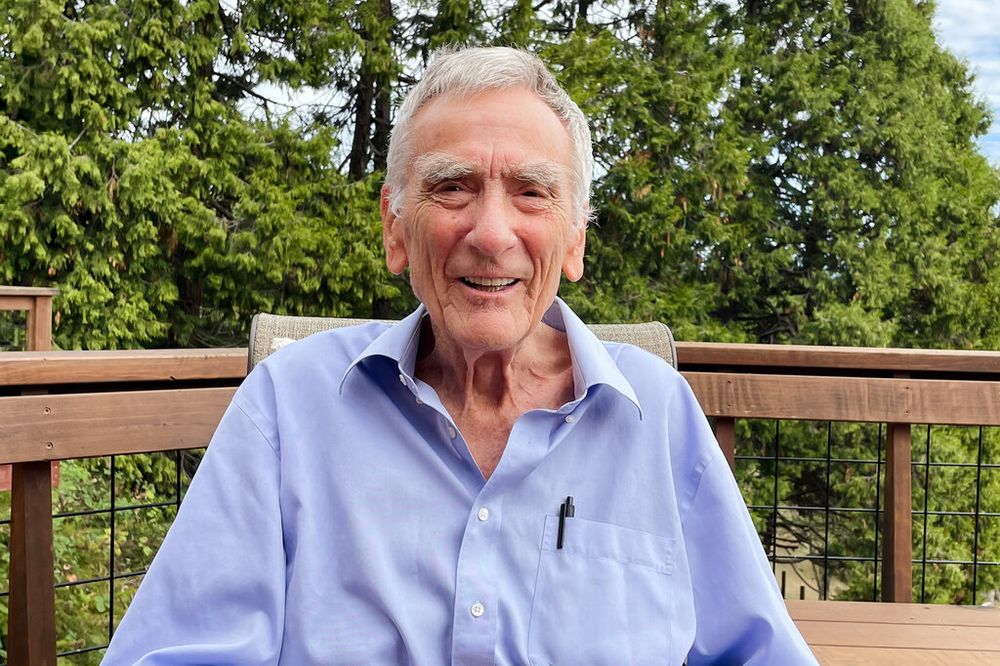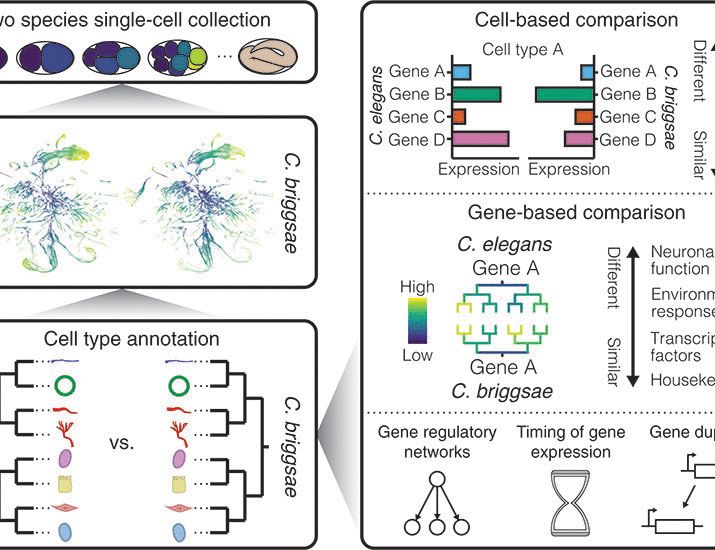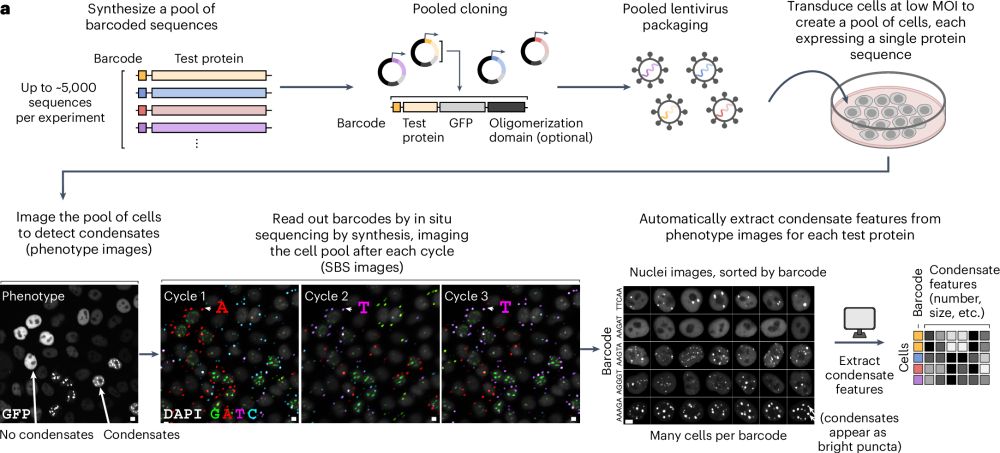Zikang (Dennis) Huang
@dennishuang.bsky.social
PhD student at Bugaj Lab UPenn | synbio | protein engineering | optogenetics | thermogenetics | systems bio | love weird dynamics, information flow, network structures of all systems | everything BcLOV4
Pinned
How can an individual protein show adaptation? The light- and temp-sensitive BcLOV4 gives a pulse of translocation during a step input of light. Answer in our preprint: *intra-molecular* feed-forward regulation. bit.ly/3Rg9veD
A @bugajlab.bsky.social collab with @nmrkaygee.bsky.social 🧵
A @bugajlab.bsky.social collab with @nmrkaygee.bsky.social 🧵
See y’all there!

November 7, 2025 at 9:33 PM
See y’all there!
😲
Japanese botanist Kenji Suetsugu studies plants that steal carbon and nutrients from soil fungi. https://scim.ag/3IRHOrW

These ‘ghost flowers’ thrive without photosynthesis. One scientist is learning how
Japanese botanist Kenji Suetsugu studies plants that steal carbon and nutrients from soil fungi
www.science.org
October 14, 2025 at 12:26 AM
😲
Reposted by Zikang (Dennis) Huang
Latest issue of curated #engineeredlivingmaterials feed:
biomed.news/bims-enlima/... #ELMs
via @biomednews.bsky.social
includes research on: boolean logic-gated protein presentation (h/t @coledeforest.bsky.social), bacterial grown living materials (h/t @proftomellis.bsky.social) & more 🧪
biomed.news/bims-enlima/... #ELMs
via @biomednews.bsky.social
includes research on: boolean logic-gated protein presentation (h/t @coledeforest.bsky.social), bacterial grown living materials (h/t @proftomellis.bsky.social) & more 🧪

Boolean logic-gated protein presentation through autonomously compiled molecular topology - Nature Chemical Biology
Programming stimulus responsiveness into living systems enables advanced biocomputation. Here, the authors autonomously compile proteins with defined topology that can be site-specifically tethered to and conditionally released from biomaterials and cells following user-specified Boolean logic.
www.nature.com
October 12, 2025 at 9:39 AM
Latest issue of curated #engineeredlivingmaterials feed:
biomed.news/bims-enlima/... #ELMs
via @biomednews.bsky.social
includes research on: boolean logic-gated protein presentation (h/t @coledeforest.bsky.social), bacterial grown living materials (h/t @proftomellis.bsky.social) & more 🧪
biomed.news/bims-enlima/... #ELMs
via @biomednews.bsky.social
includes research on: boolean logic-gated protein presentation (h/t @coledeforest.bsky.social), bacterial grown living materials (h/t @proftomellis.bsky.social) & more 🧪
Reposted by Zikang (Dennis) Huang
So sad to hear the news - John truly was an inspiration to so many, and one of a kind.
www.cam.ac.uk/research/new...
www.cam.ac.uk/research/new...

Nobel Laureate Professor Sir John Gurdon dies aged 92
It is with great sadness that the University shares the news of the death of Professor Sir John Gurdon, founder of the Gurdon Institute.
www.cam.ac.uk
October 7, 2025 at 4:02 PM
So sad to hear the news - John truly was an inspiration to so many, and one of a kind.
www.cam.ac.uk/research/new...
www.cam.ac.uk/research/new...
Reposted by Zikang (Dennis) Huang
Generative design of synthetic gene circuits for functional and evolutionary properties https://www.biorxiv.org/content/10.1101/2025.09.26.678595v1
September 28, 2025 at 3:03 AM
Generative design of synthetic gene circuits for functional and evolutionary properties https://www.biorxiv.org/content/10.1101/2025.09.26.678595v1
Reposted by Zikang (Dennis) Huang
What if you could think of every possible solution to a problem? Then you might be able to simply pick the best one - even if it was highly nonobvious. With the “tiling tree” method, you can learn, and practice, the skill of doing just that: engineeringx.substack.com/p/the-tiling...

The Tiling Tree Method
How to think of every way of solving a problem
engineeringx.substack.com
September 21, 2025 at 9:20 PM
What if you could think of every possible solution to a problem? Then you might be able to simply pick the best one - even if it was highly nonobvious. With the “tiling tree” method, you can learn, and practice, the skill of doing just that: engineeringx.substack.com/p/the-tiling...
Reposted by Zikang (Dennis) Huang
Sea slugs steal foreign chloroplasts for photosynthesis and starvation resistance. Photo by Anik Grearson. #evolution #symbiosis. #cellbiology. @cellpress.bsky.social

September 18, 2025 at 2:50 PM
Sea slugs steal foreign chloroplasts for photosynthesis and starvation resistance. Photo by Anik Grearson. #evolution #symbiosis. #cellbiology. @cellpress.bsky.social
Reposted by Zikang (Dennis) Huang
Thanks Misha for the shout-out!
It has been a truly mind-opening journey. WHOLISTIC is one step towards whole-organism neuroscience and a true physiological observatory - with extensions on the way! I am continually amazed by what the data reveals - so much remains to be discovered and mined.
It has been a truly mind-opening journey. WHOLISTIC is one step towards whole-organism neuroscience and a true physiological observatory - with extensions on the way! I am continually amazed by what the data reveals - so much remains to be discovered and mined.
Preprint -
Excited to present WHOLISTIC, which extends the concept of whole-brain functional imaging to the entire body. Pioneering work by incredibly talented Virginia Ruetten @vmsruetten.bsky.social, this platform reveals whole-organism cellular dynamics in vivo.
www.biorxiv.org/content/10.1...
Excited to present WHOLISTIC, which extends the concept of whole-brain functional imaging to the entire body. Pioneering work by incredibly talented Virginia Ruetten @vmsruetten.bsky.social, this platform reveals whole-organism cellular dynamics in vivo.
www.biorxiv.org/content/10.1...
September 8, 2025 at 4:30 PM
Thanks Misha for the shout-out!
It has been a truly mind-opening journey. WHOLISTIC is one step towards whole-organism neuroscience and a true physiological observatory - with extensions on the way! I am continually amazed by what the data reveals - so much remains to be discovered and mined.
It has been a truly mind-opening journey. WHOLISTIC is one step towards whole-organism neuroscience and a true physiological observatory - with extensions on the way! I am continually amazed by what the data reveals - so much remains to be discovered and mined.
⚡️⚡️⚡️
SCHEPHERD--the bioelectric cell herding platform built for YOU. Single cells, monolayers, organoids--this herds them all + new tricks. Plz try it-- we will *give* you parts! Teaser here of a steering a single cell. GS Yubin Lin's lifeblood with J. Yodh on piano; Celeste R. and Paul K. Thread 1/N
September 18, 2025 at 3:11 AM
⚡️⚡️⚡️
Chimeric capsid tail assembly expanding host range for hosts. Wondering if we can engineer an AND gate delivery system out of this 🤔
www.cell.com/cell/fulltex...
www.cell.com/cell/fulltex...

Chimeric infective particles expand species boundaries in phage-inducible chromosomal island mobilization
Capsid-forming PICIs (cf-PICIs) produce their own capsids and exploit phage tails
from unrelated species to transfer their DNA across bacterial hosts. This tail piracy
enables broad dissemination and ...
www.cell.com
September 14, 2025 at 1:36 AM
Chimeric capsid tail assembly expanding host range for hosts. Wondering if we can engineer an AND gate delivery system out of this 🤔
www.cell.com/cell/fulltex...
www.cell.com/cell/fulltex...
🤔
A common type of ant in Europe breaks a fundamental rule in biology: its queens can produce male offspring that are a whole different species
go.nature.com/4mOb5T9
go.nature.com/4mOb5T9

‘Almost unimaginable’: these ants are different species but share a mother
Ant queens of one species clone ants of another to create hybrid workers that do their bidding.
go.nature.com
September 11, 2025 at 1:50 AM
🤔
Reposted by Zikang (Dennis) Huang
Feeling mitochondrially challenged lately?
Here are two classic reviews on #mitochondria that should help.
www.cell.com/current-biol...
www.cell.com/current-biol...
Here are two classic reviews on #mitochondria that should help.
www.cell.com/current-biol...
www.cell.com/current-biol...

The Origin and Diversification of Mitochondria
Moving beyond the simplistic view of mitochondria as the power house of the cell,
Roger et al. present the immense diversity of mitochondria and mitochondrial functions
across eukaryotes, and bring th...
www.cell.com
August 28, 2025 at 10:28 PM
Feeling mitochondrially challenged lately?
Here are two classic reviews on #mitochondria that should help.
www.cell.com/current-biol...
www.cell.com/current-biol...
Here are two classic reviews on #mitochondria that should help.
www.cell.com/current-biol...
www.cell.com/current-biol...
Looking forward to trying it out!
Researchers have developed a #DeepLearning system called BioEmu that rapidly generates diverse protein conformations, enabling fast, accurate insights into protein flexibility and function.
Learn more this week in Science: https://scim.ag/3JdQVD4
Learn more this week in Science: https://scim.ag/3JdQVD4
August 18, 2025 at 3:30 AM
Looking forward to trying it out!
Reposted by Zikang (Dennis) Huang
The creative process in science has a set of thinking tools that we could do a better job teaching. Here are the 12 articles that Martin and I wrote about them, including "It takes two to think", "A hypothesis is a liability" and "The two languages of science". night-science.org/home/learn/r...

August 11, 2025 at 2:23 AM
The creative process in science has a set of thinking tools that we could do a better job teaching. Here are the 12 articles that Martin and I wrote about them, including "It takes two to think", "A hypothesis is a liability" and "The two languages of science". night-science.org/home/learn/r...
Wished it had more details, it weighs half after replication does not reject the dispersive replication hypothesis.
Franklin W. Stahl, 95, Dies; Helped Create a ‘Beautiful’ DNA Experiment. Gift article:
www.nytimes.com/2025/07/07/s...
www.nytimes.com/2025/07/07/s...

Franklin W. Stahl, 95, Dies; Helped Create a ‘Beautiful’ DNA Experiment
www.nytimes.com
July 9, 2025 at 2:44 AM
Wished it had more details, it weighs half after replication does not reject the dispersive replication hypothesis.
Reposted by Zikang (Dennis) Huang
New paper 📣! Pixelgen reports its incredible new Proximity Network Assay (PNA)->3D maps of 155 proteins in single cells by sequencing by barcoded antibodies and in situ rolling circle amplification yields >40,000 spatial nodes/cell: www.biorxiv.org/content/10.1...

June 25, 2025 at 1:45 PM
New paper 📣! Pixelgen reports its incredible new Proximity Network Assay (PNA)->3D maps of 155 proteins in single cells by sequencing by barcoded antibodies and in situ rolling circle amplification yields >40,000 spatial nodes/cell: www.biorxiv.org/content/10.1...
Now at molecular mechanisms in evolution GRC! Please stop by my poster tmr #1 and Mon/Tues #52! Will be presenting the Synergistic tuning of intramolecular feed-forward regulation shapes adaptive response of photoreceptors through domain co-evolution! Also see an earlier thread here:
How can an individual protein show adaptation? The light- and temp-sensitive BcLOV4 gives a pulse of translocation during a step input of light. Answer in our preprint: *intra-molecular* feed-forward regulation. bit.ly/3Rg9veD
A @bugajlab.bsky.social collab with @nmrkaygee.bsky.social 🧵
A @bugajlab.bsky.social collab with @nmrkaygee.bsky.social 🧵
June 22, 2025 at 12:44 AM
Now at molecular mechanisms in evolution GRC! Please stop by my poster tmr #1 and Mon/Tues #52! Will be presenting the Synergistic tuning of intramolecular feed-forward regulation shapes adaptive response of photoreceptors through domain co-evolution! Also see an earlier thread here:
Reposted by Zikang (Dennis) Huang
Happy to announce our paper comparing embryonic gene expression between C. elegans and C. briggsae, work led by Christopher Large with Rupa Khanal and in collaboration with Junhyong Kim and Bob Waterston. www.science.org/doi/10.1126/...

Lineage-resolved analysis of embryonic gene expression evolution in C. elegans and C. briggsae
The constraints that govern the evolution of gene expression patterns across development remain unclear. Single-cell RNA sequencing can detail these constraints by systematically profiling homologous ...
www.science.org
June 20, 2025 at 8:25 PM
Happy to announce our paper comparing embryonic gene expression between C. elegans and C. briggsae, work led by Christopher Large with Rupa Khanal and in collaboration with Junhyong Kim and Bob Waterston. www.science.org/doi/10.1126/...
Reposted by Zikang (Dennis) Huang
🐠🦠Why can’t bacteria swim like fish?
At microscopic scales, physics changes — viscosity rules! Researchers at our institute study how microbes like E. coli overcome this challenge with clever strategies like run-and-tumble.
Watch our new video:
youtu.be/drwCRRD7CGY?...
At microscopic scales, physics changes — viscosity rules! Researchers at our institute study how microbes like E. coli overcome this challenge with clever strategies like run-and-tumble.
Watch our new video:
youtu.be/drwCRRD7CGY?...

Tiny swimmers
YouTube video by MPIPKS
youtu.be
June 17, 2025 at 7:45 AM
🐠🦠Why can’t bacteria swim like fish?
At microscopic scales, physics changes — viscosity rules! Researchers at our institute study how microbes like E. coli overcome this challenge with clever strategies like run-and-tumble.
Watch our new video:
youtu.be/drwCRRD7CGY?...
At microscopic scales, physics changes — viscosity rules! Researchers at our institute study how microbes like E. coli overcome this challenge with clever strategies like run-and-tumble.
Watch our new video:
youtu.be/drwCRRD7CGY?...
Beautiful work Kalli and team! Congrats!🎉
In the nucleus, many intrinsically disordered proteins (IDPs) form condensates. What IDP sequence features drive this behavior? We developed CondenSeq, a high-throughput approach to measure nuclear condensate formation, and applied it to ~14,000 IDPs to find out!
rdcu.be/eq975
rdcu.be/eq975

Characterizing protein sequence determinants of nuclear condensates by high-throughput pooled imaging with CondenSeq
Nature Methods - CondenSeq is an imaging-based, high-throughput platform for characterizing condensate formation within the nuclear environment, uncovering the protein sequence features that...
rdcu.be
June 17, 2025 at 1:26 PM
Beautiful work Kalli and team! Congrats!🎉






